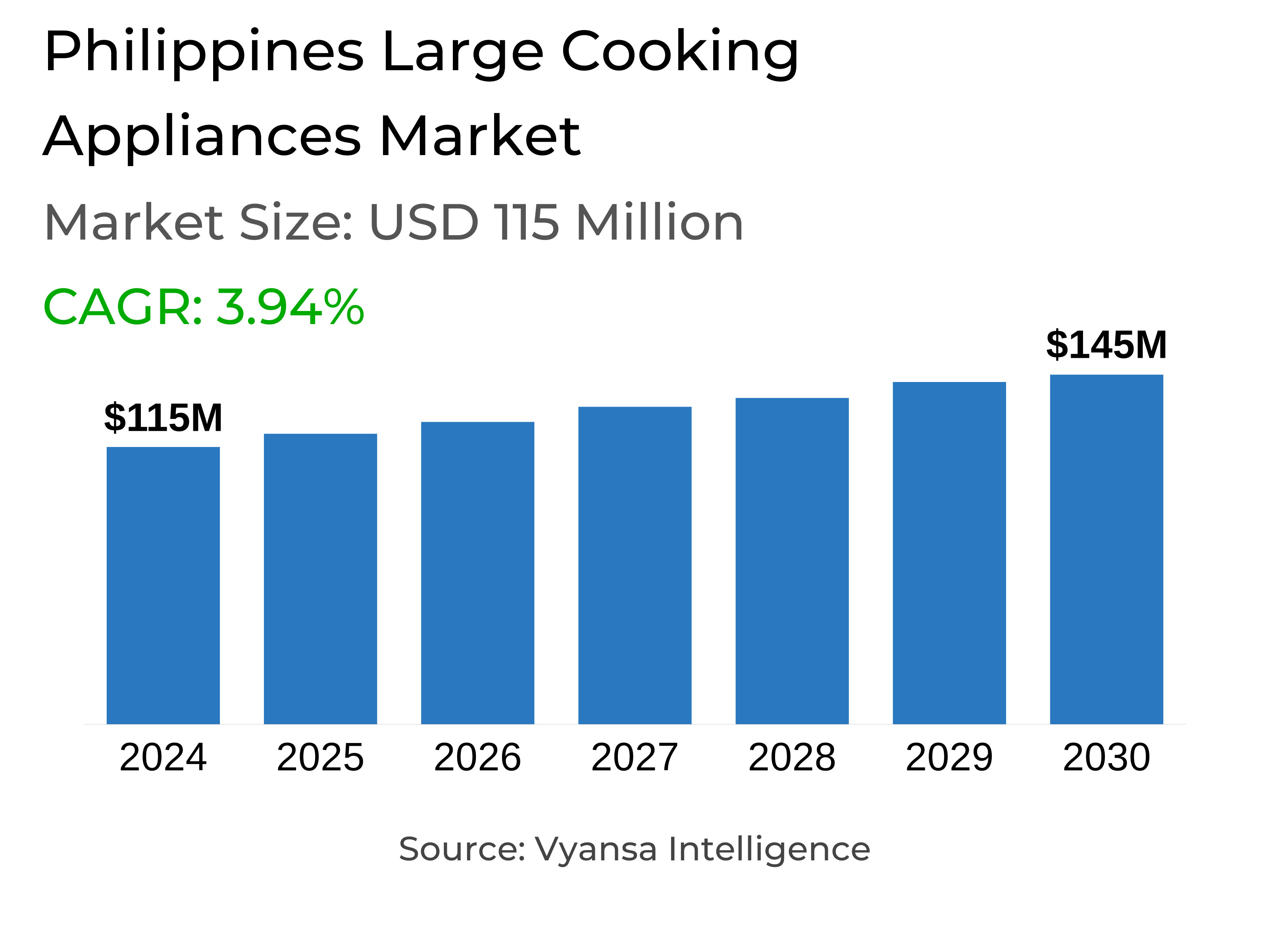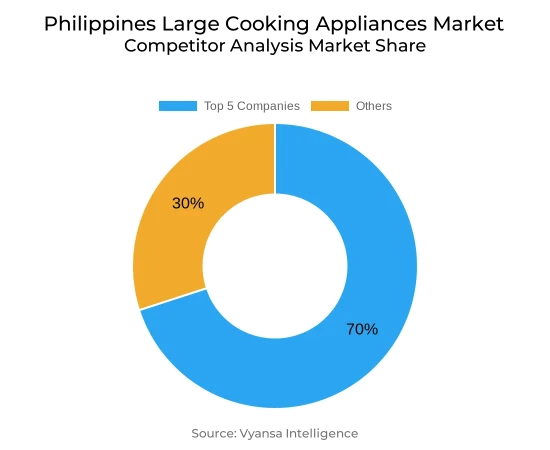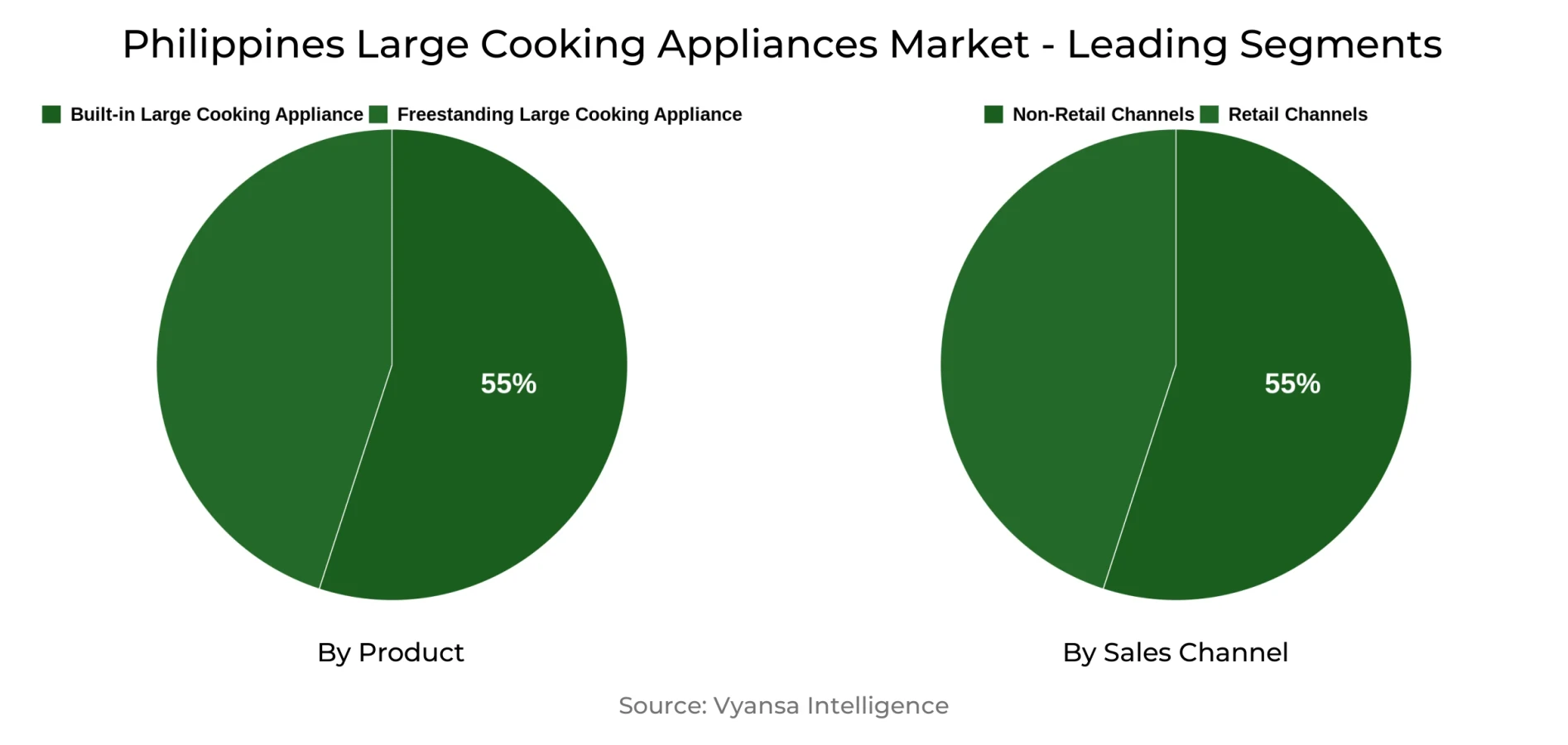
Philippines Large Cooking Appliances Market Report: Trends, Growth and Forecast (2025-2030)
By Product (Built-in Large Cooking Appliance, Freestanding Large Cooking Appliance), By Application (Household, Commercial), By Sales Channel (Retail Channels, Non-Retail Channels)
- FMCG
- Oct 2025
- VI0044
- 115
-




Philippines Large Cooking Appliances Market Statistics, 2025
- Market Size Statistics
- Large Cooking Appliances in Philippines is estimated at $ 115 Million.
- The market size is expected to grow to $ 145 Million by 2030.
- Market to register a CAGR of around 3.94% during 2025-30.
- Product Shares
- Built-in Large Cooking Appliances grabbed market share of 55%.
- Built-in Large Cooking Appliances to witness a volume CAGR of around 5.77%.
- Competition
- More than 10 companies are actively engaged in producing Large Cooking Appliances in Philippines.
- Top 5 companies acquired 70% of the market share.
- Whirlpool Corp, Electrolux Philippines Inc, Philips, Bertazzoni SpA, Haier Electrical Appliances Philippines Inc etc., are few of the top companies.
- Sales Channel
- Non-Retail Channels grabbed 55% of the market.
Philippines Large Cooking Appliances Market Outlook
The Philippines large cooking appliance market, which will register steady growth during 2025-2030, led predominantly by rising demand for cooker hoods and built-in hobs. Urban consumers are increasingly attracted towards built-in hobs because of growing awareness, decreasing prices, and promotional activity. Prices now approximate USD200, a decline from USD400 even two years ago, making it possible for more middle-income households to switch from freestanding appliances. The increasing population of residents in apartments and small houses is also fueling this trend, backed by influencer partnerships and promotion drives.
The market will further be supported by increasing emphasis on home looks, particularly among upper-middle and high-end households. Consumers are becoming more interested in those appliances that match interior design and enhance home comfort. This is compelling retailers to improve their showrooms and store displays to enable consumers to visualize built-in kitchen sets more effectively, in most cases leading to the purchase of more than one appliance simultaneously.
Retail and online channels will lead the sales by the close of the forecast period, surpassing construction-related purchases. With La Germania and Fujidenzo providing better-looking and more pocket-friendly products, consumers are moving from the erstwhile builder-supplied offerings to retail-bought appliances. Retailing penetration into tier 2 and tier 3 cities will also be responsible for tapping the country's growing disposable income levels.
But expansion for cookers and ovens will be stayed by top-of-the-line prices and lack of space in most Filipino kitchens. These items will continue to be pitched primarily to upper-income buyers with spacious kitchens, more as complementary items in whole kitchen sets.

Philippines Large Cooking Appliances Market Growth Driver
Affordability will probably continue to be a high priority for Filipino shoppers when buying big cooking appliances in 2025-30. The appliances are viewed as big, aspirational purchases, and a lot of shoppers will be nervous because of economic issues and increasing energy prices. Accordingly, they might opt for lower-priced options. Yet the increasing price of gas will drive some demand towards electric models, particularly those perceived as more energy efficient.
Consumers will also concentrate on functionality and durability when choosing appliances. They will perform extensive research of product specifications, compare prices, and prefer products with longer guarantees and good user reviews. Promotional discounts and offers will also appeal to new buyers of products such as built-in hobs and range hoods, underpinning sales growth over the forecast period.
Philippines Large Cooking Appliances Market Trend
Filipino buyers, especially Millennials and Gen Z consumers, are increasingly seeking major cooking appliances that complement the overall design and look of their houses. Since most consumers spend more time indoors and also receive guests, aesthetics of appliances are now as relevant as the form. Social media is playing a significant factor here, as buyers wish their homes to be presentable on photographs and videos posted online.
This trend will go on to accelerate even more in 2025-30. Manufacturers and retailers will be encouraged to counter this by providing a more diverse range of fashion-forward designs and adaptable options. Catchy store presentations will also gain significance to attract customers. Aesthetic design not only enhances visual beauty but also contributes to home living comfort, leaving consumers feeling rejuvenated in their own space.
Philippines Large Cooking Appliances Market Opportunity
La Germania, a product of Bertazzoni SpA, is set to maintain its dominance in the big cooking appliances market thanks to aggressive online advertising, monthly promotions, and social media campaigns. The efforts of the brand to reach consumers outside of Metro Manila via recipe videos and cooking tutorials have established robust brand awareness. Furthermore, its collaboration with TendoPay to provide 10-24 monthly payments at 0% interest enables its fashionable, affordable products to reach wider consumers.
At the same time, Elba has progressively captured share from 2020 to 2023 by going after construction projects and interior decorators. Although its price is higher and it does not conduct online campaigns like La Germania, its emphasis on showrooms and displays has worked to reach professionals constructing entire sets of kitchens. Both approaches identify different growth channels, showing both online interaction and sales through projects will keep presenting good opportunities in the Philippines.
| Report Coverage | Details |
|---|---|
| Market Forecast | 2025-30 |
| USD Value 2024 | $ 115 Million |
| USD Value 2030 | $ 145 Million |
| CAGR 2025-2030 | 3.94% |
| Largest Category | Built-in Large Cooking Appliances segment leads with 50% market share |
| Top Drivers | Affordability and Energy Efficiency to Shape Consumer Preferences |
| Top Trends | Rising Preference for Aesthetic and Stylish Home Appliances |
| Top Opportunities | Growing Brand Engagement Through Online & Offline Channels |
| Key Players | Whirlpool Corp, Electrolux Philippines Inc, Philips, Bertazzoni SpA, Haier Electrical Appliances Philippines Inc, Excellence Appliance Technologies Inc, Indesit Co SpA, Appstar Global Distributors Inc, Samsung Electronics, LG Electronics and Others. |
Philippines Large Cooking Appliances Market Segmentation Analysis

The largest market share in the Philippines Large Cooking Appliances Market in 2025–30 belongs to the non-retail channel consisting of builder merchants and the building industry. This segment generated over 50% of the sales in 2024, primarily due to the increasing number of high-end housing developments in urban areas such as Metro Manila. In such developments, big cooking appliances tend to be bundled as part of the value proposition, limiting consumers from buying them separately.
But the market is slowly coming around as more budget-friendly brands such as La Germania and Fujidenzo become increasingly popular. As awareness grows and installation becomes easier with the help of manufacturers and retailers, consumers are transitioning from freestanding to built-in forms, preferring to purchase through retail outlets or the internet. With growing retail and e-commerce channels, these are likely to overtake the construction-driven segment by the end of the forecast period.
Top Companies in Philippines Large Cooking Appliances Market
The top companies operating in the market include Whirlpool Corp, Electrolux Philippines Inc, Philips, Bertazzoni SpA, Haier Electrical Appliances Philippines Inc, Excellence Appliance Technologies Inc, Indesit Co SpA, Appstar Global Distributors Inc, Samsung Electronics, LG Electronics, etc., are the top players operating in the Philippines Large Cooking Appliances Market.
Frequently Asked Questions
Related Report
1. Market Segmentation
1.1. Research Scope
1.2. Research Methodology
1.3. Definitions and Assumptions
2. Executive Summary
3. Philippines Large Cooking Appliance Market Policies, Regulations, and Standards
4. Philippines Large Cooking Appliance Market Dynamics
4.1. Growth Factors
4.2. Challenges
4.3. Trends
4.4. Opportunities
5. Philippines Large Cooking Appliance Market Statistics, 2020-2030F
5.1. Market Size & Growth Outlook
5.1.1.By Revenues in US$ Million
5.1.2.By Unit Sold in Thousand Units
5.2. Market Segmentation & Growth Outlook
5.2.1.By Product
5.2.1.1. Built-in Large Cooking Appliance- Market Insights and Forecast 2020-2030, USD Million
5.2.1.1.1. Built-in Hobs- Market Insights and Forecast 2020-2030, USD Million
5.2.1.1.1.1. Gas- Market Insights and Forecast 2020-2030, USD Million
5.2.1.1.1.2. Induction- Market Insights and Forecast 2020-2030, USD Million
5.2.1.1.1.3. Mixed- Market Insights and Forecast 2020-2030, USD Million
5.2.1.1.1.4. Standard Electric- Market Insights and Forecast 2020-2030, USD Million
5.2.1.1.1.5. Vitroceramic- Market Insights and Forecast 2020-2030, USD Million
5.2.1.1.2. Ovens- Market Insights and Forecast 2020-2030, USD Million
5.2.1.1.2.1. Smart- Market Insights and Forecast 2020-2030, USD Million
5.2.1.1.2.2. Non-Smart- Market Insights and Forecast 2020-2030, USD Million
5.2.1.1.3. Built-in Cooker Hoods- Market Insights and Forecast 2020-2030, USD Million
5.2.1.2. Freestanding Large Cooking Appliance- Market Insights and Forecast 2020-2030, USD Million
5.2.1.2.1. Freestanding Cooker Hoods- Market Insights and Forecast 2020-2030, USD Million
5.2.1.2.2. Cookers- Market Insights and Forecast 2020-2030, USD Million
5.2.2.By Application
5.2.2.1. Household- Market Insights and Forecast 2020-2030, USD Million
5.2.2.2. Commercial- Market Insights and Forecast 2020-2030, USD Million
5.2.3.By Sales Channel
5.2.3.1. Retail Channels- Market Insights and Forecast 2020-2030, USD Million
5.2.3.1.1. Retail Offline- Market Insights and Forecast 2020-2030, USD Million
5.2.3.1.2. Retail E-Commerce- Market Insights and Forecast 2020-2030, USD Million
5.2.3.2. Non-Retail Channels- Market Insights and Forecast 2020-2030, USD Million
5.2.3.2.1. Builder Merchants and Construction- Market Insights and Forecast 2020-2030, USD Million
5.2.4.By Competitors
5.2.4.1. Competition Characteristics
5.2.4.2. Market Share & Analysis
6. Philippines Built-in Large Cooking Appliance Market Statistics, 2020-2030F
6.1. Market Size & Growth Outlook
6.1.1.By Revenues in US$ Million
6.1.2.By Unit Sold in Thousand Units
6.2. Market Segmentation & Growth Outlook
6.2.1.By Product- Market Insights and Forecast 2020-2030, USD Million
6.2.2.By Application- Market Insights and Forecast 2020-2030, USD Million
6.2.3.By Sales Channel- Market Insights and Forecast 2020-2030, USD Million
7. Philippines Freestanding Large Cooking Appliance Market Statistics, 2020-2030F
7.1. Market Size & Growth Outlook
7.1.1.By Revenues in US$ Million
7.1.2.By Unit Sold in Thousand Units
7.2. Market Segmentation & Growth Outlook
7.2.1.By Product- Market Insights and Forecast 2020-2030, USD Million
7.2.2.By Application- Market Insights and Forecast 2020-2030, USD Million
7.2.3.By Sales Channel- Market Insights and Forecast 2020-2030, USD Million
8. Competitive Outlook
8.1. Company Profiles
8.1.1.Bertazzoni SpA
8.1.1.1. Business Description
8.1.1.2. Product Portfolio
8.1.1.3. Collaborations & Alliances
8.1.1.4. Recent Developments
8.1.1.5. Financial Details
8.1.1.6. Others
8.1.2.Haier Electrical Appliances Philippines Inc
8.1.2.1. Business Description
8.1.2.2. Product Portfolio
8.1.2.3. Collaborations & Alliances
8.1.2.4. Recent Developments
8.1.2.5. Financial Details
8.1.2.6. Others
8.1.3.Excellence Appliance Technologies Inc
8.1.3.1. Business Description
8.1.3.2. Product Portfolio
8.1.3.3. Collaborations & Alliances
8.1.3.4. Recent Developments
8.1.3.5. Financial Details
8.1.3.6. Others
8.1.4.Indesit Co SpA
8.1.4.1. Business Description
8.1.4.2. Product Portfolio
8.1.4.3. Collaborations & Alliances
8.1.4.4. Recent Developments
8.1.4.5. Financial Details
8.1.4.6. Others
8.1.5.Appstar Global Distributors Inc
8.1.5.1. Business Description
8.1.5.2. Product Portfolio
8.1.5.3. Collaborations & Alliances
8.1.5.4. Recent Developments
8.1.5.5. Financial Details
8.1.5.6. Others
8.1.6.Whirlpool Corp
8.1.6.1. Business Description
8.1.6.2. Product Portfolio
8.1.6.3. Collaborations & Alliances
8.1.6.4. Recent Developments
8.1.6.5. Financial Details
8.1.6.6. Others
8.1.7.Electrolux Philippines Inc
8.1.7.1. Business Description
8.1.7.2. Product Portfolio
8.1.7.3. Collaborations & Alliances
8.1.7.4. Recent Developments
8.1.7.5. Financial Details
8.1.7.6. Others
8.1.8.Philips
8.1.8.1. Business Description
8.1.8.2. Product Portfolio
8.1.8.3. Collaborations & Alliances
8.1.8.4. Recent Developments
8.1.8.5. Financial Details
8.1.8.6. Others
8.1.9.Samsung Electronics
8.1.9.1. Business Description
8.1.9.2. Product Portfolio
8.1.9.3. Collaborations & Alliances
8.1.9.4. Recent Developments
8.1.9.5. Financial Details
8.1.9.6. Others
8.1.10. LG Electronics
8.1.10.1. Business Description
8.1.10.2. Product Portfolio
8.1.10.3. Collaborations & Alliances
8.1.10.4. Recent Developments
8.1.10.5. Financial Details
8.1.10.6. Others
9. Disclaimer
| Segment | Sub-Segment |
|---|---|
| By Product |
|
| By Application |
|
| By Sales Channel |
|
Research Methodology
This study followed a structured approach comprising four key phases to assess the size and scope of the electro-oxidation market. The process began with thorough secondary research to collect data on the target market, related markets, and broader industry context. These findings, along with preliminary assumptions and estimates, were then validated through extensive primary research involving industry experts from across the value chain. To calculate the overall market size, both top-down and bottom-up methodologies were employed. Finally, market segmentation and data triangulation techniques were applied to refine and validate segment-level estimations.
Secondary Research
The secondary research phase involved gathering data from a wide range of credible and published sources. This step helped in identifying industry trends, defining market segmentation, and understanding the market landscape and value chain.
Sources consulted during this phase included:
- Company annual reports, investor presentations, and press releases
- Industry white papers and certified publications
- Trade directories and market-recognized databases
- Articles from authoritative authors and reputable journals
- Gold and silver standard websites
Secondary research was critical in mapping out the industry's value chain and monetary flow, identifying key market segments, understanding regional variations, and tracking significant industry developments.
Other key sources:
- Financial disclosures
- Industry associations and trade bodies
- News outlets and business magazines
- Academic journals and research studies
- Paid industry databases
Primary Research
To validate secondary data and gain deeper market insights, primary research was conducted with key stakeholders across both the supply and demand sides of the market.
On the demand side, participants included decision-makers and influencers from end-user industries—such as CIOs, CTOs, and CSOs—who provided first-hand perspectives on market needs, product usage, and future expectations.
On the supply side, interviews were conducted with manufacturers, industry associations, and institutional participants to gather insights into current offerings, product pipelines, and market challenges.
Primary interviews provided critical inputs such as:
- Market size and revenue data
- Product and service breakdowns
- Market forecasts
- Regional and application-specific trends
Stakeholders consulted included:
- Leading OEM and solution providers
- Channel and distribution partners
- End users across various applications
- Independent consultants and industry specialists
Market Size Estimation and Data Triangulation
- Identifying Key Market Participants (Secondary Research)
- Goal: To identify the major players or companies in the target market. This typically involves using publicly available data sources such as industry reports, market research publications, and financial statements of companies.
- Tools: Reports from firms like Gartner, Forrester, Euromonitor, Statista, IBISWorld, and others. Public financial statements, news articles, and press releases from top market players.
- Extracting Earnings of Key Market Participants
- Goal: To estimate the earnings generated from the product or service being analyzed. This step helps in understanding the revenue potential of each market player in a specific geography.
- Methods: Earnings data can be gathered from:
- Publicly available financial reports (for listed companies).
- Interviews and primary data sources from professionals, such as Directors, VPs, SVPs, etc. This is especially useful for understanding more nuanced, internal data that isn't publicly disclosed.
- Annual reports and investor presentations of key players.
- Data Collation and Development of a Relevant Data Model
- Goal: To collate inputs from both primary and secondary sources into a structured, data-driven model for market estimation. This model will incorporate key market KPIs and any independent variables relevant to the market.
- Key KPIs: These could include:
- Market size, growth rate, and demand drivers.
- Industry-specific metrics like market share, average revenue per customer (ARPC), or average deal size.
- External variables, such as economic growth rates, inflation rates, or commodity prices, that could affect the market.
- Data Modeling: Based on this data, the market forecasts are developed for the next 5 years. A combination of trend analysis, scenario modeling, and statistical regression might be used to generate projections.
- Scenario Analysis
- Goal: To test different assumptions and validate how sensitive the market is to changes in key variables (e.g., market demand, regulatory changes, technological disruptions).
- Types of Scenarios:
- Base Case: Based on current assumptions and historical data.
- Best-Case Scenario: Assuming favorable market conditions, regulatory environments, and technological advancements.
- Worst-Case Scenario: Accounting for adverse factors, such as economic downturns, stricter regulations, or unexpected disruptions.
Partnering With Industry Leaders to Drive Growth
Our mission is to deliver intelligence that matters. By combining data, analysis, and industry expertise, we enable organizations to make smarter, faster, and more impactful decisions. Whether it’s a Fortune 500 company or a high-growth startup, businesses trust us to provide clarity in an ever-evolving marketplace.






